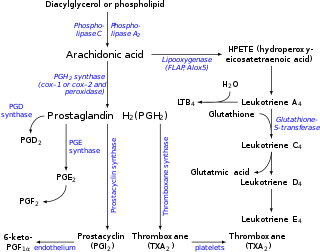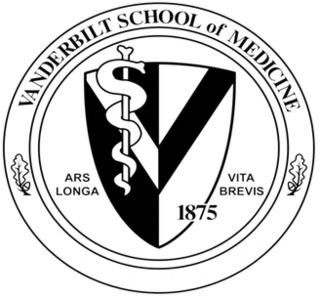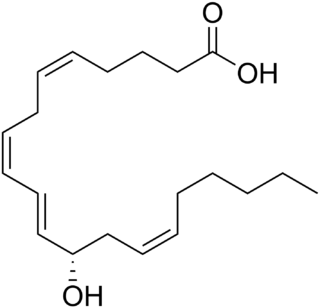Related Research Articles

The American Association for the Advancement of Science (AAAS) is a United States–based international nonprofit with the stated mission of promoting cooperation among scientists, defending scientific freedom, encouraging scientific responsibility, and supporting scientific education and science outreach for the betterment of all humanity. AAAS was the first permanent organization established to promote science and engineering nationally and to represent the interests of American researchers from across all scientific fields. It is the world's largest general scientific society, with over 120,000 members, and is the publisher of the well-known scientific journal Science.

Eicosanoids are signaling molecules made by the enzymatic or non-enzymatic oxidation of arachidonic acid or other polyunsaturated fatty acids (PUFAs) that are, similar to arachidonic acid, around 20 carbon units in length. Eicosanoids are a sub-category of oxylipins, i.e. oxidized fatty acids of diverse carbon units in length, and are distinguished from other oxylipins by their overwhelming importance as cell signaling molecules. Eicosanoids function in diverse physiological systems and pathological processes such as: mounting or inhibiting inflammation, allergy, fever and other immune responses; regulating the abortion of pregnancy and normal childbirth; contributing to the perception of pain; regulating cell growth; controlling blood pressure; and modulating the regional flow of blood to tissues. In performing these roles, eicosanoids most often act as autocrine signaling agents to impact their cells of origin or as paracrine signaling agents to impact cells in the proximity of their cells of origin. Some eicosanoids, such as prostaglandins, may also have endocrine roles as hormones to influence the function of distant cells.

Earl Wilbur Sutherland Jr. was an American pharmacologist and biochemist born in Burlingame, Kansas. Sutherland won a Nobel Prize in Physiology or Medicine in 1971 "for his discoveries concerning the mechanisms of the action of hormones", especially epinephrine, via second messengers, namely cyclic adenosine monophosphate, or cyclic AMP.

Alfred Goodman Gilman was an American pharmacologist and biochemist. He and Martin Rodbell shared the 1994 Nobel Prize in Physiology or Medicine "for their discovery of G-proteins and the role of these proteins in signal transduction in cells."
Craig Jon Hawker is an Australian-born chemist. His research has focused on the interface between organic and polymer chemistry, with emphasis on the design, synthesis, and application of well-defined macromolecular structures in biotechnology, microelectronics, and surface science. Hawker holds more than 45 U.S. patents, and he has co-authored over 300 papers in the areas of nanotechnology, materials science, and chemistry. He was listed as one of the top 100 most cited chemists worldwide over the decade 1992–2002, and again in 2000–2010.

Sir John Henry Gaddum was an English pharmacologist who, along with Ulf von Euler, co-discovered the neuropeptide Substance P in 1931. He was a founder member of the British Pharmacological Society and first editor of the British Journal of Pharmacology.

Vanderbilt University School of Medicine (VUSM) is the graduate medical school of Vanderbilt University, a private research university located in Nashville, Tennessee. The School of Medicine is primarily housed within the Eskind Biomedical Library which sits at the intersection of the Vanderbilt University and Vanderbilt University Medical Center (VUMC) campuses and claims several Nobel laureates in the field of medicine. Through the Vanderbilt Health Affiliated Network, VUSM is affiliated with over 60 hospitals and 5,000 clinicians across Tennessee and five neighboring states which manage more than 2 million patient visits each year. As the home hospital of the medical school, VUMC is considered one of the largest academic medical centers in the United States and is the primary resource for specialty and primary care in hundreds of adult and pediatric specialties for patients throughout the Mid-South.
Jeffrey Ivan Gordon is a biologist and the Dr. Robert J. Glaser Distinguished University Professor and Director of the Center for Genome Sciences and Systems Biology at Washington University in St. Louis. He is internationally known for his research on gastrointestinal development and how gut microbial communities affect normal intestinal function, shape various aspects of human physiology including our nutritional status, and affect predisposition to diseases. He is a member of the National Academy of Sciences, the American Academy of Arts and Sciences, the Institute of Medicine of the National Academies, and the American Philosophical Society.

Epidermis-type lipoxygenase 3 is a member of the lipoxygenase family of enzymes; in humans, it is encoded by the ALOXE3 gene. This gene is located on chromosome 17 at position 13.1 where it forms a cluster with two other lipoxygenases, ALOX12B and ALOX15B. Among the human lipoxygenases, ALOXE3 is most closely related in amino acid sequence to ALOX12B. ALOXE3, ALOX12B, and ALOX15B are often classified as epidermal lipoxygenases, in distinction to the other three human lipoxygenases, because they were initially defined as being highly or even exclusively expressed and functioning in skin. The epidermis-type lipoxygenases are now regarded as a distinct subclass within the multigene family of mammalian lipoxygenases with mouse Aloxe3 being the ortholog to human ALOXE3, mouse Alox12b being the ortholog to human ALOX12B, and mouse Alox8 being the ortholog to human ALOX15B [supplied by OMIM]. ALOX12B and ALOXE3 in humans, Alox12b and Aloxe3 in mice, and comparable orthologs in other in other species are proposed to act sequentially in a multistep metabolic pathway that forms products that are structurally critical for creating and maintaining the skin's water barrier function.
Jeffrey R. Balser is the president and CEO of Vanderbilt University Medical Center (VUMC) and dean of the Vanderbilt University School of Medicine (VUSM). Balser is a 1990 graduate of the Vanderbilt M.D./Ph.D. program in pharmacology and subsequently completed residency training in anesthesiology and fellowship training in critical care medicine at Johns Hopkins. He continued to work at Johns Hopkins as a cardiac anesthesiologist and ICU physician before returning to Vanderbilt University and joining VUMC in 1998. Balser was appointed dean of the VUSM in 2008 and, the following year, was appointed the vice chancellor for health affairs at Vanderbilt, in charge of the medical center. He became president and CEO of VUMC in 2016 when the medical center became a financially distinct non-profit organization.

CYP4F22 is a protein that in humans is encoded by the CYP4F22 gene.

12-Hydroxyeicosatetraenoic acid (12-HETE) is a derivative of the 20 carbon polyunsaturated fatty acid, arachidonic acid, containing a hydroxyl residue at carbon 12 and a 5Z,8Z,10E,14Z cis–trans configuration (Z=cis, E=trans) in its four double bonds. It was first found as a product of arachidonic acid metabolism made by human and bovine platelets through their 12S-lipoxygenase (i.e. ALOX12) enzyme(s). However, the term 12-HETE is ambiguous in that it has been used to indicate not only the initially detected "S" stereoisomer, 12S-hydroxy-5Z,8Z,10E,14Z-eicosatetraenoic acid (12(S)-HETE or 12S-HETE), made by platelets, but also the later detected "R" stereoisomer, 12(R)-hydroxy-5Z,8Z,10E,14Z-eicosatetraenoic acid (also termed 12(R)-HETE or 12R-HETE) made by other tissues through their 12R-lipoxygenase enzyme, ALOX12B. The two isomers, either directly or after being further metabolized, have been suggested to be involved in a variety of human physiological and pathological reactions. Unlike hormones which are secreted by cells, travel in the circulation to alter the behavior of distant cells, and thereby act as endocrine signalling agents, these arachidonic acid metabolites act locally as autocrine signalling and/or paracrine signaling agents to regulate the behavior of their cells of origin or of nearby cells, respectively. In these roles, they may amplify or dampen, expand or contract cellular and tissue responses to disturbances.

Fred Sherman was an American scientist who pioneered the use of the budding yeast Saccharomyces cerevisiae as a model for studying the genetics, molecular biology, and biochemistry of eukaryotic cells. His research encompassed broad areas of yeast biology including gene expression, protein synthesis, messenger RNA processing, bioenergetics, and mechanisms of mutagenesis. He also contributed extensively to the genetics of the opportunistic pathogen Candida albicans.

15-Hydroxyeicosatetraenoic acid (also termed 15-HETE, 15(S)-HETE, and 15S-HETE) is an eicosanoid, i.e. a metabolite of arachidonic acid. Various cell types metabolize arachidonic acid to 15(S)-hydroperoxyeicosatetraenoic acid (15(S)-HpETE). This initial hydroperoxide product is extremely short-lived in cells: if not otherwise metabolized, it is rapidly reduced to 15(S)-HETE. Both of these metabolites, depending on the cell type which forms them, can be further metabolized to 15-oxo-eicosatetraenoic acid (15-oxo-ETE), 5(S),15(S)-dihydroxy-eicosatetraenoic acid (5(S),15(S)-diHETE), 5-oxo-15(S)-hydroxyeicosatetraenoic acid (5-oxo-15(S)-HETE), a subset of specialized pro-resolving mediators viz., the lipoxins, a class of pro-inflammatory mediators, the eoxins, and other products that have less well-defined activities and functions. Thus, 15(S)-HETE and 15(S)-HpETE, in addition to having intrinsic biological activities, are key precursors to numerous biologically active derivatives.
Bimal Kumar Bachhawat was an Indian neurochemist and glycobiologist, known for his discovery of HMG-CoA lyase, an intermediate in the mevalonate and ketogenesis pathway, and for the elucidation of the molecular cause of metachromatic leukodystrophy, a hereditary disease of the brain His studies on sugar-bearing liposomes led to its use as a carrier for in situ delivery of drugs and hormones to diseased organs and he pioneered the therapy of systemic fungal infections using liposomal formulations. He was a recipient of several awards including the Shanti Swarup Bhatnagar Award, the highest Indian honor in science and technology and an elected fellow of three major Indian science academies. The Government of India awarded him the third highest civilian honour of the Padma Bhushan, in 1990, for his contributions to science.
Marion Sewer (1972-2016) was a pharmacologist and professor at the University of California, San Diego's Skaggs School of Pharmacy and Pharmaceutical Sciences known for her research on steroid hormone biogenesis and her commitment to increasing diversity in science. Much of her research centered around cytochrome P450, a family of enzymes involved in the conversion of cholesterol into steroid hormones. She died unexpectedly at the age of 43 from a pulmonary embolism on January 28, 2016, while traveling through the Detroit airport.

Namandjé N. Bumpus is an American pharmacologist who serves as the Principal Deputy Commissioner and Acting Chief Scientist of the Food and Drug Administration. She was previously director of the department of pharmacology and molecular sciences at Johns Hopkins University School of Medicine, where she holds the E.K. Marshall and Thomas H. Maren professorship in pharmacology. Bumpus is known for her research on the metabolism of antiviral drugs used to treat HIV-1 and how genetic variations in drug-processing enzymes may impact these drugs' efficacy. Bumpus received a Presidential Early Career Award for Scientists and Engineers in 2016. The Food and Drug Administration’s top scientist Namandjé Bumpus has assumed the role of principal deputy commissioner when longtime agency leader Janet Woodcock retired from that role in January 2024.
Nancy J. Brown is an American physician-scientist. She is the Jean and David W. Wallace Dean and C.N.H. Long Professor of Internal Medicine at Yale University School of Medicine, having formerly served as the Hugh Jackson Morgan Professor of Medicine and Pharmacology, and Chair and Physician-in-Chief of the Department of Medicine at Vanderbilt University School of Medicine.
Bonnie Fiedorek Sloane was a distinguished professor at Wayne State University known for her research on cancer. In 2021 she was elected a fellow of the American Association for the Advancement of Science.

Mark Wallace is an American neuroscientist currently holding the Louise B. McGavock Chair of Neuroscience at Vanderbilt University.
References
- 1 2 "Vanderbilt celebrates 18 elected fellows of the AAAS". Vanderbilt University. 25 November 2013. Retrieved 29 October 2015.
- ↑ "A R Brash" (PDF). The Strathallian . Vol. 9, no. 3. Autumn 1970. p. 13. Archived from the original (PDF) on 17 November 2015. Retrieved 29 October 2015.
- 1 2 3 4 5 6 Brash, Alan R (September 2009). "Mechanistic aspects of CYP74 allene oxide synthases and related cytochrome P450 enzymes". Phytochemistry . 70 (13–14): 1522–1531. Bibcode:2009PChem..70.1522B. doi:10.1016/j.phytochem.2009.08.005. PMC 2783490 . PMID 19747698.
- ↑ Alan R. Brash author entry at OpenAlex
- ↑ "AAAS Members Elected as Fellows". Science . 342: 1064. 29 November 2013. doi: 10.1126/science.342.6162.1062 .